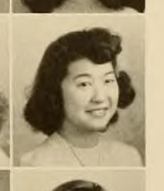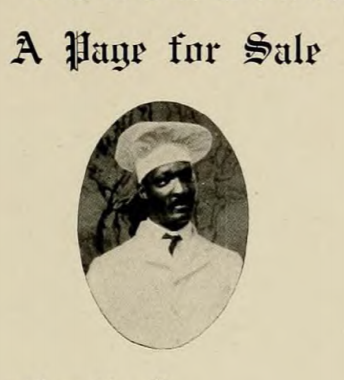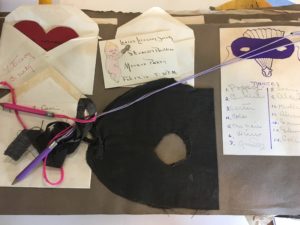The idea for a building for alumnae emerged in 1920 as President Samuel Page Duke considered the needs of a growing campus. He became president in August 1919, as the first World War and global pandemic were still winding down and disruptions persisted. The Harrisonburg Normal School (formerly the State Normal and Industrial School for Women at Harrisonburg), which had closed temporarily during the pandemic, was bursting again with new students. The young women came from all over Virginia, eager to gain the kinds of skills and knowledge needed to join the workforce, which desperately sought women workers to replace men in all kinds of fields. Duke need funds for everything: dormitories, classrooms, offices, and even the social spaces so necessary for student life. The Alumnae Association quickly stepped in to help raise money.
Continue readingCategory Archives: JMU Campus History
Yuri Nemoto: Madison’s First Asian American Student

A few years ago, I purchased a 1944 School Ma’am in a local antique store and was astounded to find inside two photographs of an Asian American Madison College student named Yuri Nemoto. A quick search of The Breeze turned up a brief 1943 interview that refers to her as the “first” student “of Japanese descent,” which means she is likely the first Asian American. Nemoto told the reporter, an unidentified fellow classmate, that she was from Los Angeles, had come to Virginia on a scholarship to Lynchburg College, and transferred to Madison that fall intending to study dietetics. Well. I had so many questions after reading that. How had she not been sent to a detention camp along with more than 110,000 to 120,000 other people of Japanese ancestry? What had it been like for her to be a Japanese American attending a whites-only Southern school during World War II? My research revealed a compelling story of resistance and resilience.
Continue readingPage S. Mitchell, Chef and Kitchen Manager

Page Mitchell was one of the most significant employees at the State Normal and Industrial School for Women, for he managed the kitchen that provided three meals a day to hundreds of white students and faculty. Hired as the school’s cook, he is shown in a 1914 image, at left, in chef’s whites. Like Walker Lee and the handful of other African Americans that worked on this campus in the early 20th century, Mitchell contributed to the school’s success, however, little information about him survives in school sources. In this post, I’ll piece together what I have learned about his work so far.
Continue readingSheary Darcus: JMU’s 1st Black Graduate in Context
In April 2020, The Madison Magazine, JMU’s alumni publication, featured Dr. Sheary Darcus Johnson, whom the institution recognizes as its first African American graduate. I provided some important historical context for that cover story and reproduce my sidebar here, followed by an update related to other early Black students. [read more]
Continue readingStudent Orgs, the Lost Cause, and Belongingness
NB: I started this post in 2019 but completed/updated it in response to JMU’s July 2020 decision to remove the names of Confederate officers from campus buildings. This post references historic examples of racist and oppressive imagery and language.
In 2019, some Kappa Alpha brothers from Ole Miss made headlines when they used Emmett Till’s memorial marker for target practice and reignited old debates about fraternities and other student orgs that invoke the Lost Cause. The Kappa Alpha Order, a fraternity established in 1865 at Washington College in Virginia, claims Confederate General Robert E. Lee as its “spiritual founder,” and is widely recognized by historians for its veneration of the Old South and its particular brand of white, Southern masculinity. Lee became their icon because he served as president of that college from 1865 to his death in 1870, when campus authorities renamed it Washington and Lee. KA chapters expanded over time, and by the 1950s and 1960s, were widely known for hosting elaborate “plantation” parties, flying Confederate flags, and actively opposing efforts to desegregate higher education. (Turner, Coski) JMU’s KA chapter dates to the 1994-95 academic year, when opposition to affirmative action admissions was nationally prominent, and this campus, like many others, struggled over its diversity initiatives (Breeze, 1990-2000). This post connects modern JMU student organizations’ Lost Cause activities to earlier forms, like the Lee Literary Society, and reflects on their impact on white and Black student belongingness and campus culture. [read more]
Continue readingPandemic at the Normal, 1918
Everyone wants to draw lessons from the past right now. My Twitter TL is full of links to news articles comparing the COVID-19 crisis and the 1918 influenza pandemic. There’s even a #COVID19syllabus project that gathers recent articles and supplements them with scholarly books and articles. So I couldn’t ignore the fact that my campus closed in 1918, just as it closed in March 2020. Sitting in Webex meetings with other administrators, I wondered what happened back then, what decisions those administrators made, and what impact influenza had had on the State Normal School at Harrisonburg. [read more]
Continue readingWhat’s in a Name? The JMU Quad as a Lesson Plan
I’m republishing this August 2019 post today 6/20/20 with a disclaimer: it contains references to historic ideas, words, and images that today are considered racist. I temporarily removed it because petitions linking to it were circulating on mass media and social media, and portions of it were taken out of context.
If you understand that a college campus is a commemorative landscape, that its named buildings, statuary, roadways, plazas, and so forth all comprise a text that can be read for insights into the institution’s cultural values, then you’ll appreciate it when I say that JMU’s Quad is a kind of lesson plan. Conceived by Dr. John Wayland, first professor of history at the State Normal and Industrial School for Women at Harrisonburg and head of the department of Social Studies until 1931, the plan relies on the associative properties of monuments, which call forth the great deeds and virtues of the person or Continue reading
Searching for Mr. Walker Lee
His name leaps out at me. “In Science Hall there was Walker Lee, the janitor. Short, rotund, and coal black, Walker’s smile, cheerful disposition and willingness to be of help made him a favorite with the girls. He could out spell many of them and was said to write a finer hand than President Burruss himself.” These sentences appear in Chapter 5 of Raymond C. Dingledine, Jr.’s Madison College (1958), a celebratory review of this institution’s first fifty years. Although the name is right there in black and white, the customary honorific “Mr.” is missing. Following the customs of the day, Dingledine, the Continue reading
Confronting Blackface
I’m republishing this Feb. 2019 post today 6/20/20 with a disclaimer: it contains references to historic ideas, words, and images that today are considered racist. I temporarily removed it because links to it were circulating on mass media and social media, and portions of it were taken out of context.
Blackface minstrelsy has a long history on this campus, so in light of recent revelations about state officials’ participation in related activities I thought I’d pull together some information for students wondering what the heck is going on. First, as Dr. Rhae Lynn Barnes noted in her recent WaPo essay, “The Troubling History Behind Ralph Northam’s Blackface Klan Photo,” minstrelsy was absolutely “central to civic and campus life in 20th century America.” White men, young and old, poor and elite, uneducated and erudite, not only used “the profits of amateur blackface to build white-only institutions” but, more importantly, to affirm their political, economic, and cultural Continue reading
Alumni Scrapbooks and Collective Memory
Collegiate scrapbooks are no longer a thing. Sure, modern students still take photographs to document their college years—arguably, they take even more than my generation, thanks to digital cameras–but instead of pasting images into memory books, they post them to Snapchat, Instagram, and Facebook. It’s interesting to compare the ephemerality of today’s memory-keeping activities to the materiality of yesterday’s.
Physical scrapbooks fascinate me. I’m a scrapbooker, myself, have been since middle Continue reading

